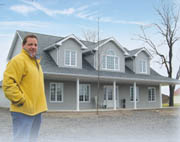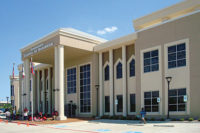
In the eyes of James LaChance, insulating concrete forms are a misunderstood construction material. These interlocking blocks, with concrete and steel rebar sandwiched between expanded polystyrene panels, are not the wall system that is meant to redefine residential styles. He states that in his local Ontario, neighbors view ICFs as "post-modern" architecture that are the antithesis to conventional Cape Cod-style homes of his area.
Although the wall system can be used for limitless residential, light commercial, institutional and industrial designs, it is not a system manufacturers and the Insulating Concrete Form Association want to promote as the sole template for modern building. The system does not discriminate: Any type of unit that is desired can be achieved with these systems.
What the ICFA and all its members make a point to illustrate is that it offers owners a structure that provides green and energy efficient advantages.

Construct Canada
LaChance, a builder whose background is in environmental technology and president of Clarity Energy Concepts, considers the ICFs just one of the many facets to his building package."The whole package consists of a super insulated exterior, super insulated windows and a super insulated wall system," he says. "We have R-60 in my attic. We have a heat recovery ventilator unit here, so we're bringing fresh air into the house constantly-I don't have indoor air quality issues. We've got a heat loss value fixed on the whole house as a structure. Basically, when we calculated it out on this house it was 43,000 Btus per hour. When you calculate the heat loss, it was at 0 degrees C (outside temperature). That told me what size geothermal unit I needed."
As a whole, what his homes offer are an emission-free space that employs the latest solar paneling and geothermal technology that altogether should pay for itself.
"We want to create the most energy efficient package to get us to Net-Zero energy in a home," he says.
Net-Zero is the terminology used when returning an equal amount of power to the grid as was consumed. To achieve Net-Zero metering, the photovoltaic cells have to be located in the correct orientation to the sun to harness its energy, while simultaneousily conserving energy consumption through the best use of a high efficiency of electrical fixtures and home appliances.

What a gas
Currently, LaChance and his wife live in the latest unit built in Mooretown, Ontario. The 2,600-square-foot home has no gas lines but runs off a geothermal heat pump, which provides the structure with all the heating and cooling (including hot water). This works together with solar panels that are placed on the house. So, for every kilowatt used during day or night the panels system is channeled to the hydrometer and spins it backwards."If we used 1,000 kilowatts per month and the sun shines making 1,000 then the house is rated as Net-Zero," LaChance says.
When Clarity Energy was researching different styles of energy-efficient homes-including Earthship construction-he found the straw bails and empty 2-liter wall foundations a risk with rodents and moisture intrusion. The ICF blocks meet all local code regulations and LaChance noticed the systems performance in the Oak Ridge National Laboratories study on exterior wall panels, which rated the 13⁄4 panels an effective R-value of R-22.
"LaChance took our one-day training course prior to starting to build," Ken Williams, sales representative with Logix, says. "I consulted on some of the construction details that would minimize waste and speed up construction. There were 543 standard and specialty block plus floor connectors, form support products and equipment rental."
LaChance has to date built three ICF homes and plans to use the system on further developments in Ontario. His staff of four build and install all the components themselves. When each of the individual houses are complete, in theory the units should benefit homeowners with utility bills four times lower, minimize the heat loss in all areas, preserve the cool temperature in the summertime because the concrete acts as thermal mass, help the environment and promote solid and sound green building.



Report Abusive Comment